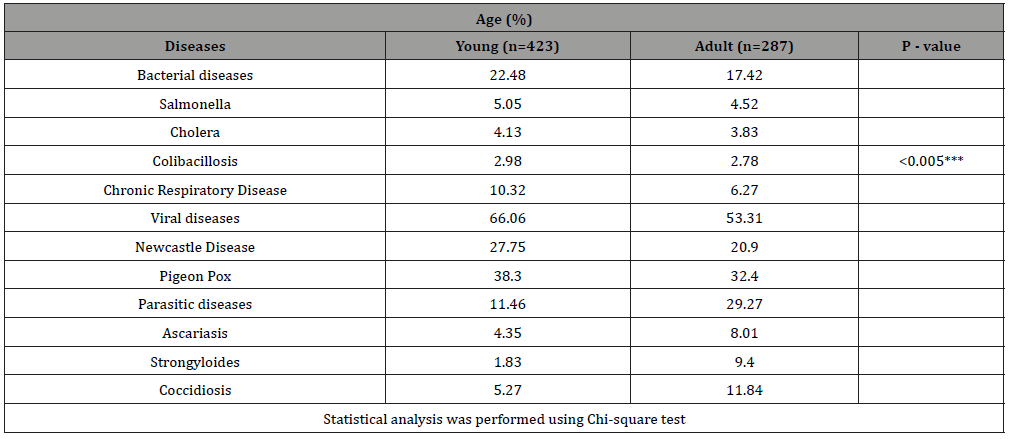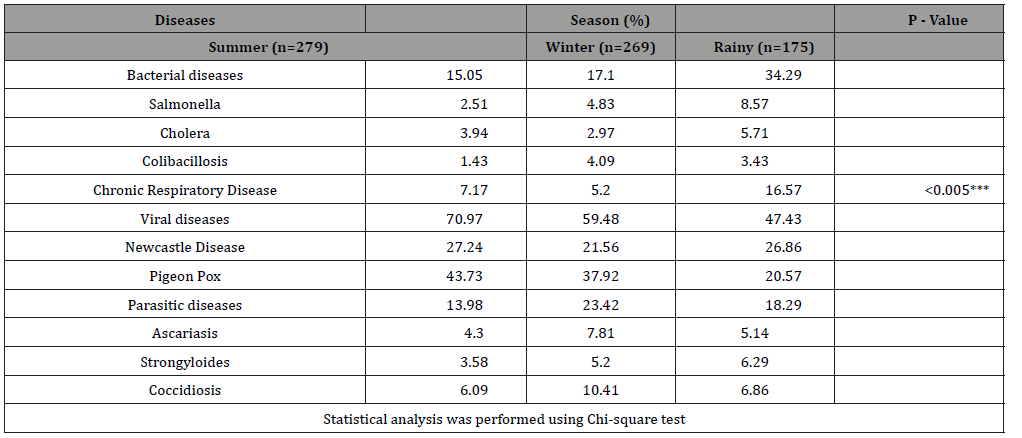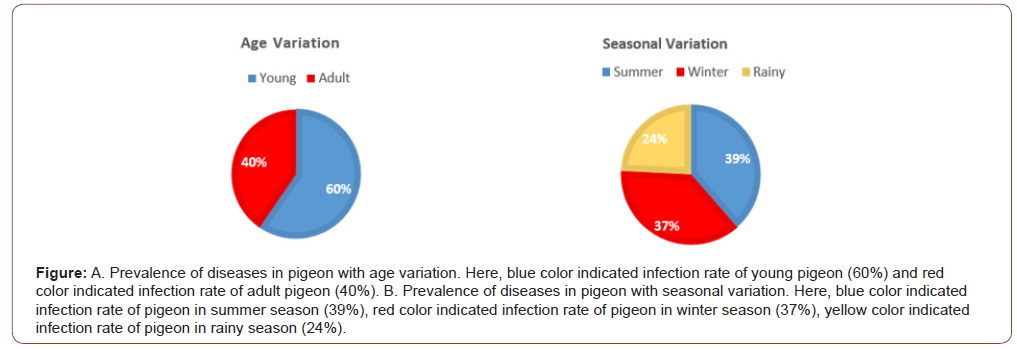 Research Article
Research Article
Prevalence of Pigeon Diseases in Sylhet District, Bangladesh
S Islam1*, MRN Akhand2, MB Khan1 and MK Hossain3
1Department of Physiology, Sylhet Agricultural University, Bangladesh
2Department of Biochemistry and Chemistry, Sylhet Agricultural University, Bangladesh
3Department of Surgery and Theriogenology, Sylhet Agricultural University, Bangladesh
Saiful Islam Department of Physiology, Sylhet Agricultural University, Sylhet-3100, Bangladesh.
Received Date: July 02, 2020; Published Date: July 29, 2020
Abstract
The study was conducted to determine the occurrence of different diseases in pigeon from January to December 2019 at Sylhet District in Bangladesh. A total of 723 pigeons either infected or dead were collected and examined to diagnose the diseases followed by clinical history, clinical signs, and postmortem lesions and laboratory examination. The data were analyzed by using chi-square test. The result, the proportion of bacterial diseases, viral diseases and parasitic diseases were 22.48%, 66.06% and 11.46% in young and 53.31% of viral, 17.4% of bacterial and 29.27% in adult pigeon respectively. While the proportion of infectious diseases was significantly higher in adult (60%) than the young pigeon (40%; P<0.005), viral diseases were the most affected the young than adult pigeon. In pigeon the occurrence of bacterial diseases was significantly higher in rainy season (34.29%) as well as summer season (17.10%) compared to winter season (15.05%; P< 0.005). However, the percentage of viral diseases was significantly highest in summer season (70.97%) as well as winter season (59.48%) compared to rainy season (47.43%) and whereas the parasitic diseases were highest in winter season (23.42%) compared to rainy season (18.29%) and summer season (13.98%). In conclude diversified diseases are prevalent in pigeon. Therefore, proper vaccination and bio-security practices and preventive measures are recommended.
Keywords: Bangladesh; Infectious disease; Pigeon; Occurrence; Sylhet
Introduction
Bangladesh is a developing country where poultry industry is one of the most rising sectors. Local chicken, ducks and pigeons are traditionally reared in either semi-intensive or intensive system by the people of Bangladesh as a source of food, hobby, and experimental purposes [1,2]. Pigeons are ubiquitous species of birds and can be found in almost all towns and cities around the world [3]. In recent time, pigeon farming is gaining popularity in Bangladesh especially in Sylhet region because people feel monotonous with chicken meat and they desire another safe meat. The domestic pigeon was derived from the rock dove or rock pigeon or common pigeon of which scientific name is Colomba livia [4]. So, to fulfill the public demand and become economically developed, many people begin pigeon farming. According to Agricultural Sample Survey in 2013, Bangladesh had a population of 10.8 million pigeons of which 11% were kept commercial farms. In past female household members are engaged with pigeon rearing [4]. But now a day’s as a second income source most of the people are involved with pigeon rearing even students also. Pigeon are highly prolific and there is a lot of demand of squab meat in the market due to its tenderness and taste [5].
Pigeon farming offering scope for reducing the unemployment problem in Bangladesh and contribute towards the increase of Gross Domestic Production (GDP) under the livestock sector. However, in recent years, pigeons are being affected with different types of diseases such as bacterial, viral, parasitic recorded by Sylhet district due to poor management system, unhygienic, lack of vaccination and medication, hazardous seasonal variation such as heat stress. In addition, pigeons play a vital role to transmit different types of disease to other pigeons, domestic animal, and poultry and especially to human [6,7], thereby acting as a carrier of these diseases. The infected pigeon shows signs of dullness, depression, and diarrhea as well. The disease is thus responsible for economic losses since it is associated with high mortality along with very high morbidity [8]. If the common diseases of pigeon are controlled, their farming system may be profitable. For management and interferences of pigeon’s illness, the primary scientific approach ought to be the entity of the disease and pathologies related to them [9]. In most cases, the diseased pigeons do not survive because the prognosis are not done properly.
To improve the pigeon farming, it is essential to know the incidence of the diseases conditions so that they could be treated in an effective way. This would be beneficial for the pigeon farmer to expand their pigeon business and contribute to the national economy. Therefore, the aim of this study is to know the prevalence of the diseases of pigeons of the pigeon farms in the Sylhet district of Bangladesh, on the basis of age and season variations.
Materials and Methods
The study was conducted from the period of January to December 2019 to reveal the present situation of pigeon diseases in commercial pigeons at Sylhet district under the Sylhet division of Bangladesh. A total of 723 pigeons (young 436 and adult 287) were diagnosed based on clinical signs, post-mortem findings and laboratory test during this period.
Clinical Signs were recorded including in depression, weakness, loss of body weight, greenish diarrhea, watery diarrhea, ruffled feather, cheesy material in mouth, one eye swelling and occulonasal discharge [28].
Post-mortem findings were considered including grey nodules in visceral organ, caseous exudates, hemorrhage, intestinal necrosis, liver swollen, pox lesions papules, vesicles and pustules, ulcerated mucosa, thickening intestinal wall [10].
Laboratory test was performed to identify coccidiosis infestation by using a fecal floatation technique [11]. Collected fecal samples were properly mixed with saturated salt solution (ratio 1:14) after that course materials were removed through filtration. Followed that liquid samples were poured on the Mc Master slide for 10 minutes and observed under microscopy.
To know the actual scenario of the disease data were recorded monthly and to study the different age group with divided into young and adult and seasonal occurrence the whole time was divided into three conventional seasons, such as Summer (March-June), Rainy (July-October) and Winter (November-February) according to Ali 2011. The obtained data were recorded into Microsoft Excel Speed Sheet and data were analyzed by using chi-square rest.
Results and Discussion
The study through pathological investigation detected many diseases in pigeons in Sylhet district. The overall prevalence of different diseases in commercial pigeon is shown in Table 1 and 2 with their age and seasonal variations, respectively.
Age variation
We classified pigeons into two categories young (1-90 days) and adult (>90days). Total number of 723 pigeons was observed, among them bacterial diseases, viral diseases and parasitic diseases were 22.48%, 66.06% and 11.46% respectively (Table 1). In bacterial diseases, young pigeon was affected in Salmonellosis (5.05%), cholera (4.13%), Colibacillosis (2.98%) and Chronic Respiratory Disease (CRD) (10.32%) whereas adult pigeon was affected with 4.52% in Salmonella, 3.83% in cholera, 2.87% in Colibacillosis and 6.27% in CRD. Among bacterial diseases, CRD was significantly higher in young (10.32%) and adult pigeon (6.27%) than other bacterial diseases. In viral diseases young pigeons were affected in 27.75% and 38.30% in Newcastle Disease (ND) and pigeon pox where adult pigeon was affected in 20.90% and 32.40% in ND and pigeon pox respectively (Table 1). In parasitic infestation young pigeon were affected with 4.35%, 1.83% and 5.27% in Ascariasis, Strongyloidiasis and Coccidiosis respectively and adult pigeon were affected with 8.01% in Ascariasis, 9.40% in Strongyloidiasis, and 11.84% in Coccidiosis.
According to the result, the proportion of infection rate is significantly higher in young pigeon than adult (Figure 1a). While viral diseases are significantly higher in young followed by bacterial and parasitic diseases are considerably higher in adult pigeon. Table 1 showed that the occurrence of bacterial and viral diseases was considerably higher in young pigeon than adults whereas parasitic diseases were high in adults than young. The findings are similar with that of Islam 2009 [12]. The findings are supported by Anonymous 1997 shown that bacterial disease is usually more frequent in young birds compared to mature birds in duck.
Seasonal variation: Total numbers of 723 pigeons was observed in which 279 were in summer, 269 in winter, 175 in Rainy seasons (Table 2). The proportion of infection in pigeon were 39% in summer, 37% in winter and 24% in rainy season (Figure 1b). (In summer, pigeons were affected in bacterial (15.05%), viral (70.97%) and parasitic (13.98%) diseases (Table 2). In case of winter and rainy season pigeons were affected with 17.10% and 34.29% with bacterial, 59.48% and 47.43% with viral and 23.42% and 18.29% with parasitic diseases respectively (Table 2).
Table 1: Prevalence of diseases in pigeon with Age variation.

Table 2: Prevalence of diseases in pigeon with seasonal variation.


According to season, there was a significant different of infection rate in pigeon among season (p<0.005). The incidence of pigeon is significantly higher in summer followed by winter and rainy season. In summer, occurrence of viral diseases was significantly higher (70.97%) followed by winter (59.48%) and rainy (47.43%) season and this result was similar with that of [13- 16]. The incidence of pigeon pox was significantly higher in summer (43.73%), winter (37.92%) compared to ND in summer (27.24%) and winter 21.56%) whereas observed ND (26.86%) and pigeon pox (20.57%) in rainy season counterparts. On the other hand, the incidence of ND was also high in winter season then followed by summer and rainy season in chicken [17].
In case of bacterial diseases, there were a significant rise in rainy (34.29%) compared to winter (17.10%) and summer (15.05%) season whereas parasitic diseases were more considerably affected at 23.42% in winter than almost 18.29% and 13.42% in rainy and summer respectively (p <0.005) (Table 2). The similar findings were observed in chicken and duck diseases according to [17-20].
Our finding indicates that Pox and ND in commercial pigeon were still a threat to the poultry which might be due to geographical variation, compact pigeon population, incorrect vaccination, presence of maternal antibody, defective storage, and administration of vaccine [21-24]. As causes of parasitic infestation found within those pigeon farm, the owner could not use regular doses of anthelmintic and irregular cleaning of pigeon nest. [25-28] Bacterial diseases occur in pigeon farms through infected pigeon which were taken from the market by the farmer and give access to nest with other pigeon without any treatment or quarantine, and contaminated feeds and faulty management system are another cause.
Conclusion
The study revealed that viral diseases are the major threat to pigeons. In age related case young pigeons are more susceptible to different infectious diseases than adult. These diseases are directly or indirectly causing economic losses of the farmers as well as national economy. So, it is essential to take an immediate attempt to control these diseases for the development of the pigeon farming of the Sylhet district.
Acknowledgments
The authors are cordially acknowledged to the Department of Physiology, SAU, Sylhet, for providing financial and logistic supports of successfully implementations during research work.
Conflict of Interest
The authors declare that they have no competing interests.
References
- Sari B, Karatepe B, Karatepe M, Kara M (2008) Parasites of domestic (Columba livia domestica) and wild (Columba livia livia) pigeons in Niǧde, Bulletin of the Veterinary Institute in Pulawy 52(4): 551-554.
- Marques SMT, RM de Cuadros, C Jda Silva , M Baldo (2007) Parasites of pigeons ( Columba livia ) in urban areas of lages, Southern Parasitol. Latinoam 62: 183-187.
- Marques SMT, De Quadros RM, Da Silva CJ, Baldo M (2007) Parasites of pigeons (Columba livia) in urban areas of lages, Southern Brazil. Parasitologia Latinoamericana 62(3–4): 183-187.
- Paul TK, Amin,MR, Alam MA, Rahman MK, Sarker YA et al. (2015) Occurrence of pigeon diseases at Khulna Sadar, Bangladesh Journal of Veterinary Medicine 13(2): 21-25.
- Anonymous (1997) National Poultry Improvement Plan and Auxiliary United States Development of Agriculture. Animal and Health Inspection Services APHIS 91-55-038.
- Begum N, Mamun M, Rahman S, Bari A (1970) Epidemiology and pathology of Trichomonas gallinae in the common pigeon (Columba livia). Journal of the Bangladesh Agricultural University 6(2): 301-306.
- Khan MS, Samad H A (2008) Prevalence of Trichomoniasis in Domestic and Wild Pigeons and Its Effects on Hematological Pakistan Veterinary Journal 28(2): 89-91.
- Al-Sadi, Hafidh I, Hamodi, Aws Z (2011) Prevalence and pathology of trichomoniasis in free - living urban pigeons in the city of Mosul, Veterinary World, 4(1): 12-14.
- Arfin S, Sayeed MA, Sultana S, Dash AK, Hossen ML (2019) Prevalence of Trichomonas gallinae infection in Pigeon of Jessore District, Journal of Advanced Veterinary and Animal Research, 6(4): 549-552.
- Susan E Aiello, Michael A Moses, Dana G Allen (2016) The Merck veterinary Kenilworth, Merck & Co., Inc. NJ, USA.
- Presswell B,Lagrue C (2016) Assessing parasite infections from avian faecal samples: The old methods 63: 32-36.
- Nasrin MM (2004) Parasites of pigeon (Columba livia) in Mymensingh district, M. S. thesis. Submitted to the Department of Parasitology, Faculty of Veterinary Science, Bangladesh Agricultural University, Mymensingh.
- Rahman M (2019) Occurrence of poultry diseases at Kishoregonj district of Bangladesh. 8(1): 8-13.
- Mushi EZ, Binta MG, Chabo RG, Mogametsi MM , Samakabadi EK (2008) Escherichia coli infections in chicken broilers in Sebele, Gaborne, Research Journal of Poultry Science 2(2): 29-34.
- Nicole L, Musangu N, Gabriel B,Joseph R (2000) Retrospective study of Escherichia coli in broilers subjected to postmortem examination and antibiotic resistance of isolates in Trinidad. Avian Diseases 44: 155-
- Tran TP, Nguyen TT, Akiba M, Ogasawara N, Shinoda D, et al. (2004) Prevalence of Salmonella in pigs, chickens and ducks in Mekong Delta, Vietnam. Journal of Veterinary Medical Science 66: 1011-1014.
- Das PM, Rajib DMM, Monira N, Islam MR (2005) A retrospective analysis on the proportional incidence of poultry diseases in greater Mymensingh district of Bangladesh. Proceedings of the Seminar. 4th International Poultry Show and Seminar 2005, 10-12 March, Bangladesh China Friendship Conference Centre, Dhaka, Bangladesh, World’ Poultry Science Association, Bangladesh Branch pp. 33-37.
- Ali MH, Bhuiyan MKJ and Alam MM (2011) Retrospective epidemiologic study of diseases in ruminants in Khagrachari Hill Tract District of Bangladesh Journal of Veterinary Medicine 9: 145-153.
- Asaduzzaman M, Mahiuddin M, Howlider MAR, Hossain MM, Yeasmin T (2012) Pigeon farming in Gouripur Upazilla of Mymensingh Bangladesh Journal of Animal Science 38: 142-150.
- Islam MR, Das BC, Hossain K, Lucky NS, Mostafa MG (2003) A study on the occurrence of poultry diseases in Sylhet region of International Journal of Poultry Science 2(5): 354-356.
- Islam MR, Khan MAHNA, Das PM ,Bari ASM (1988) Poultry diseases diagnosed at necropsy in 1997 and 1998 on the Department of Pathology of Bangladesh Agricultural University, Proceedings of the 5th BSVER Annual Scientific Conference, December 3-4, 1998, Bangladesh Agricultural University, Mymensingh.
- Islam A, Trisha A A, Das M, Amin MR (2009) Retrospective study of some poultry diseases at Gaibandha district in Bangladesh Journal of Veterinary Medicine, 7(1): 239-247.
- Sari B, Karatepe,M, Karatepe M, Kara (2008) Parasites of domestic ( Columba livia domestica ) and wild ( Columba livia livia ) pigeons in Nigde, Turkey. Bull. Vet. Inst. Pulawy 52: 551-554.
- Talha AFSM, Hossain MM, Chowdhury EH, Bari ASM, Islam MR et al. (2001) Poultry diseases occurring in Mymensingh district of The Bangladesh Veterinarian 18: 20-23.
- Giasuddin M, Sil BK, Alam J, Koike I, Islam MR, et al. (2002) Prevalence of poultry diseases in Online Journal of Biological Sciences 2 (4): 212-213.
- Presswell B, Lagrue C (2016) Assessing parasite infections from avian faecal samples: The old methods are still the Notornis 63(1): 32-36.
- Rahman M (2019) Occurrence of poultry diseases at Kishoregonj district of Bangladesh 8(1): 8-13.
- Sari B, Karatepe B, Karatepe M, Kara M (2008) Parasites of domestic (Columba livia domestica) and wild (Columba livia livia) pigeons in Niǧde, Bulletin of the Veterinary Institute in Pulawy 52(4): 551-554.
-
S Islam, MRN Akhand, MB Khan, MK Hossain. Prevalence of Pigeon Diseases in Sylhet District, Bangladesh. Arch Animal Husb & Dairy Sci. 2(2): 2020. AAHDS.MS.ID.000532.
-
Bangladesh; Infectious disease; Pigeon; Occurrence; Sylhet.
-

This work is licensed under a Creative Commons Attribution-NonCommercial 4.0 International License.






